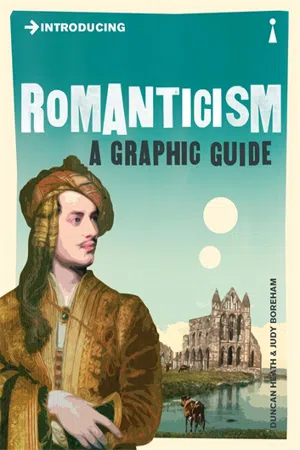![]()
What is “Romanticism”?
The word “Romantic” derives from the Old French romanz, meaning the vernacular “romance” languages that developed from Latin – Italian, French, Spanish, Portuguese, Catalan and Provengçal.
The medieval romance or romaunt came to mean a tale of chivalry written in one of these romance languages, usually in verse, and often taking the form of a quest.
Our colloquial use of “romance” and “romantic” to describe intense emotional experiences can be traced back to this medieval sense of the word, and so can the 18th and 19th century concept of “Romanticism” as an intellectual experience, which is the subject of this book.
“Romantick”
The word “romantic” came into common usage in English in the 18th century, by which time the connotations of the medieval romance had expanded to encompass a wide-ranging taste for the picturesque and the fanciful: the cult of sensibility (or sentiment) of the mid-18th century. The classically-minded Samuel Johnson (1709–84), sceptical of the new tendency, defined “Romantick” in his Dictionary of 1755:
“Romantic” had in fact been used since the Renaissance to suggest free expression of the imagination in the arts, but mainly in a negative sense. Romantic imaginings were thought to interfere with the clarity of the art form, and so lay beyond the bounds of proper subject-matter. The emerging Romantic spirit of 18th century England was seen by some as a revival of Elizabethan literature and its “Gothic” tendencies. English Romanticism has been described as a “renaissance of the Renaissance”.
Thanks to the influence of late 18th century German cultural theorists, “Romanticism” was adopted across Europe and the New World as a convenient description for distinctively contemporary modes of thought, losing in the process many of its negative connotations.
Johnson, a man of the 18th century Enlightenment, had defined the word in terms of its past…
Instead of “improbable” notions and “false” sensibility, Romanticism came to stand for authenticity, integrity and spontaneity. It was seen as a positive artistic and intellectual assertion of the extremes in the human psyche, the areas of experience beyond logic and reason which could only be expressed in a direct and heartfelt way. These new concerns were seen as a valid response to the extremes of change and uncertainty which the age itself displayed.
“Romantisch”
In 1798, the German critic and philosopher Friedrich von Schlegel (1772–1829) used the term romantisch to describe contemporary forms of artistic expression, relating it particularly to what he called “progressive universal poetry”.
But what had happened in the forty years between Johnson and Schlegel to make such a difference in their attitudes? The Western world had been shaken by two political revolutions, in America (1776) and France (1789), and by an industrial revolution which was beginning to erode the traditionally agrarian lives of many people.
New ways of living had to be reflected in new ways of thinking. Romanticism, for want of any better word, came to stand for this new experience of the world. The true Romantic was not an over-sensitive dreamer, but a heroic figure facing head-on the painful realities of his time – a figure of genius.
The Problem Child of the Enlightenment
To understand Romanticism, it is necessary first to understand the Enlightenment. As the “problem child” of this great movement, Romanticism shows many of the characteristics of its parent, but equally some radical differences.
The Enlightenment affected most of the Western world during the late 17th and 18th centuries. It was above all a movement which sought to emancipate mankind, regardless of political frontiers, from the triple tyranny of despotism, bigotry and superstition. What were the weapons in this fight?
Momentous advances occurred in science, philosophy and politics. The discoveries of Sir Isaac Newton (1642–1727) confirmed the regular and ordered nature of the universe. The philosopher John Locke (1632–1704) asserted that only the information of the senses, experience and observation could provide true understanding of the external world. Scientific knowledge could banish superstition.
Universal Enlightenment
The aim of intellectuals was to cosmopolitanize their work and make inquiry an international activity which would shed light on the universal collective condition of man. The American and French Revolutions were given their intellectual basis by the common struggle for secular humanistic ideals which, in spite of their differences of opinion, united intellectuals across the Western world. The German philosopher Immanuel Kant was in no doubt about this …
Philosophers, satirists, scientists, artists, politicians and intellectuals attempted to banish man’s dependence on received wisdom and the authority of the Church in favour of a theory of existence in which man could stand unaided at the centre of his own rational universe.
Intellectual inquiry across the Western world was marked by a spirit of unity and self-confidence. The colossal Encyclopédie supervised by Denis Diderot (1713–84), a work which attempted to bring together the accumulated wisdom of the age using the talents of its foremost intellects, was the definitive product of the Enlightenment ethos.
Rationalism (the theory that reason is the foundation of certainty in knowledge) Materialism (the theory that nothing exists but matter, and that its movements govern consciousness and will)
Empiricism (the theory that observation and experiment are the foundation for knowledge)
Determinism (the theory that human action is not free, but determined by motives regarded as external forces acting on the will)
Utilitarianism (the theory that the moral dimension of human actions is determined by their capacity to produce happiness)
These were some of the philosophical approaches of the age. Man was potentially perfectible, and the universe potentially discoverable, through the action of the intellect.
Reason and Feeling
But it would be misleading to suppose that the Enlightenment was a coherent programme that privileged reason...









